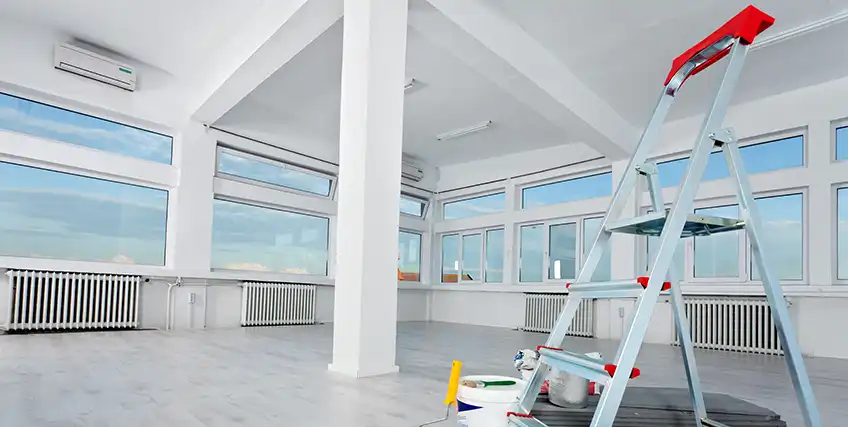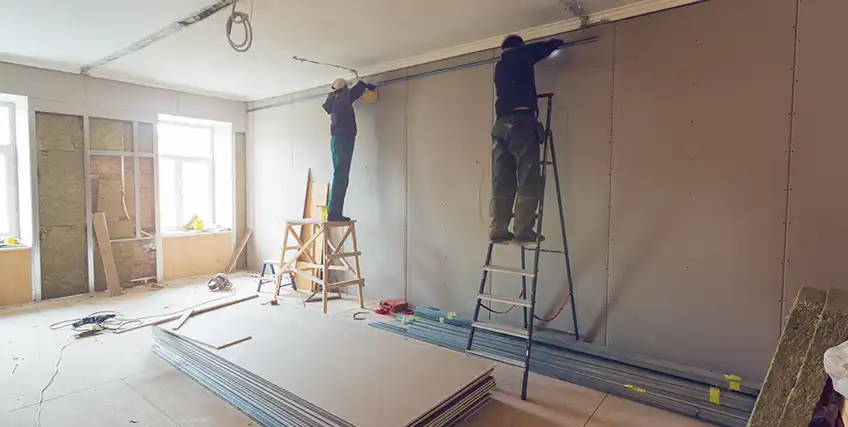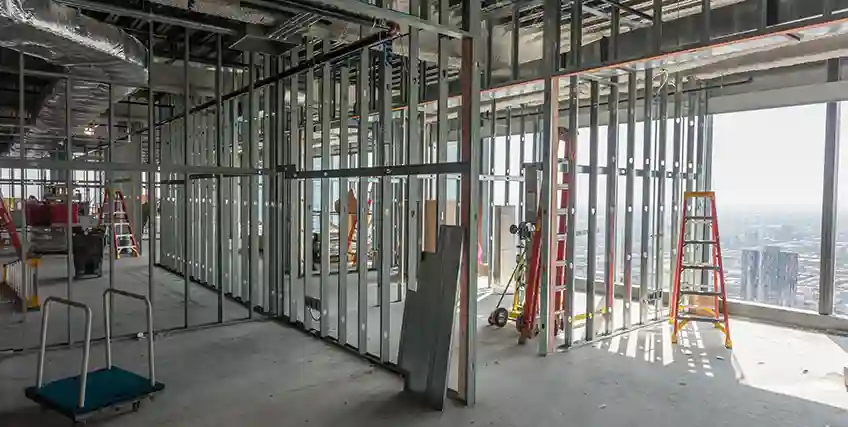Applying for an SBA Loan as an Interior Repair Business Owner
June 04, 2025 | Last Updated on: June 09, 2025

Interior repair businesses often need more than just creativity and tools—they need funding. Renovating a commercial space or upgrading outdated interiors takes cash. However, many small business owners can’t afford to dip into their working capital for large renovation projects. That’s where an SBA loan for renovations comes in.
Backed by the U.S. Small Business Administration, this financing option helps interior repair and renovation businesses cover the costs of upgrades, expansions, or major repairs. Whether you’re planning a layout change, replacing worn-out flooring, or investing in energy-efficient lighting, these loans can support your vision without draining your cash flow.
Need to improve a shared workspace? An office renovation loan can help modernize it for your team and clients. Looking for long-term, low-cost funding? SBA loans are among the most effective financial renovation solutions available today.
Even better, these business loans to renovate often come with longer repayment terms, lower interest rates, and smaller down payments compared to traditional loans. If you own or manage an interior repair business in the U.S., understanding your financing options is critical.
In this article, we’ll break down the different SBA loan types, who qualifies, how to apply, and what to avoid during the process.
Understanding SBA Loans for Renovation Projects
An SBA loan for renovation projects is a small business financing option designed to help owners upgrade or repair their commercial property. It’s backed by the U.S. Small Business Administration but funded through banks, credit unions, and certified development companies (CDCs). The SBA guarantee reduces risk for the lender, which makes it easier for business owners to qualify.
If you run an interior repair or renovation business, chances are you need to fix or upgrade spaces regularly, either your own office or a client’s property. That’s where these loans come in. You can use an SBA loan for renovation projects to fund projects like structural repairs, HVAC replacements, layout redesigns, or ADA compliance upgrades. Whether you're updating your headquarters or buying materials for a client's renovation, this loan covers both.
Loan amounts can go up to $5.5 million, depending on the type of loan you choose. The most common programs are the SBA 7(a) and SBA 504 loan. For qualified applicants, both programs come with longer repayment terms, lower down payment requirements, and better interest rates than most traditional funding options.
If your project involves updating an existing office space, an office renovation loan through SBA channels could be your best bet. For larger real estate improvements, the SBA 504 loan is often preferred. These programs are widely considered reliable financial renovation solutions for growing firms.
Unlike many business loans to renovate, SBA loans can fund both minor updates and major construction. Plus, they preserve your working capital while improving your property’s long-term value.
By investing in your facility now, you strengthen your brand, attract better clients, and set up your business for future growth.
Why Interior Repair Businesses Should Consider SBA Loans for Renovations
Running an interior repair business means you’re always dealing with changes like new trends, aging buildings, and demanding clients. But renovations cost money. Whether it’s updating walls, improving lighting, or adding workstations, expenses can pile up fast. That’s why many business owners turn to the SBA loan for renovations.
This funding option allows you to complete essential upgrades without burning through your working capital. It’s especially useful if you’ve landed a new contract, need to scale up operations, or simply want to modernize your workspace.
The SBA loan for renovation projects also helps you stay compliant. Older buildings often require updates to meet safety codes, ADA regulations, or environmental standards. You can address these issues now and avoid fines later.
Compared to traditional credit lines or short-term financing, SBA loans are smarter financial renovation solutions. They give you room to grow while maintaining a steady cash flow.
If your business is focused on improving other people’s spaces, it makes sense to improve your own. Renovating your office or workshop sends the right message to clients and employees. It shows professionalism and pride.
Don't let limited funds hold back your vision. Explore business loans to renovate your space, elevate your brand, and get the room you need to expand.
Types of SBA Loans for Renovation Projects
SBA offers several loan options for renovation-related projects. Choosing the right one depends on the size of your business, the scope of your renovation, and how quickly you need funding. Below are the three most relevant choices for interior repair businesses.
1. SBA 7(a) Loans
The SBA 7(a) loan is the most flexible option available. It covers a wide range of uses—renovations, leasehold improvements, working capital, and more. If you're looking for an SBA loan for renovation projects that can also handle other business expenses, this is a solid choice.
Loan amounts go up to $5 million, with repayment terms of up to 25 years for real estate-related projects. It’s ideal for interior businesses planning to upgrade or expand an existing space.
The application process can take time, but it may be worth it. You can get lower interest rates and a more manageable monthly payment if you are a qualified applicant. This loan works well whether you need an office renovation loan or broader financial renovation solutions.
2. SBA 504 Loans
The SBA 504 loan is designed specifically for major investments in fixed assets like commercial real estate or large-scale renovations. It’s commonly used by growing interior repair businesses that own their space and want to upgrade it.
This SBA loan for renovation provides long-term, fixed interest rate financing, often with a 10% down payment. It’s structured through a 50/40/10 model - 50% bank, 40% certified development company (CDC), and 10% from the borrower.
If you’re planning significant construction or heavy upgrades to your existing building, this loan offers strong support. It’s ideal when you want to lock in long-term savings while raising your property value.
Perfect for business loans to renovate that need a higher funding cap.
3. SBA Express Loans
If speed matters, the SBA Express loan is your go-to option. It offers faster funding decisions than other SBA programs. While the funding cap is lower ($500,000), it’s ideal for smaller renovation projects.
These loans are easier to apply for and come with fewer documentation requirements. They’re well-suited for startups or businesses needing urgent fixes to an existing facility.
Use it for minor build-outs, replacing fixtures, or adding workspaces. While rates may be slightly higher, quick access to funds may make it worth it.
Eligibility Criteria for SBA Loan for Renovation Projects
Not every interior repair business will qualify for an SBA loan for renovations. But if your business is structured correctly and meets the basic requirements, you will likely have a strong chance. Here’s what you need to meet:
1. For-Profit Business
Your business must be legally registered and operate as a for-profit entity. Nonprofits, passive investors, or speculative ventures won’t qualify. The SBA only supports businesses that actively participate in the economy and generate revenue. If you're running an interior repair firm that works on commercial property, this box should be easy to check.
2. U.S.-Based and Actively Operating
You must operate in the U.S. or its territories. Your physical location, employees, and revenue must come from domestic activities. The Small Business Administration prioritizes funding for businesses that contribute to the local economy. If your renovation firm serves U.S.-based clients, you’re likely in the clear for this eligibility requirement under the SBA renovation loan guidelines.
3. Meet SBA Size Standards
The SBA has strict size rules to determine what qualifies as a “small business.” For most service-based businesses like interior renovation, the cap is under $15 million in net worth and $5 million in average net income over two years. These standards ensure SBA funds go to truly small businesses. You can check your NAICS code on sba.gov to confirm your eligibility.
4. Owner Involvement
If you own 20% or more of the business, you’ll be required to sign a personal guarantee. This holds you accountable for repayment. It shows that the business owner is invested in the outcome of the loan. For interior repair businesses, especially smaller teams, this condition usually applies to the founder or lead partner.
5. Good Credit and Repayment Ability
While there's no fixed credit score requirement, most lenders prefer a score of 650 or higher. More importantly, your cash flow should support your expected monthly payments. Lenders will assess your revenue, debt obligations, and banking history. They’ll want to see that you can comfortably handle the loan without straining your operations.
6. Clear Loan Purpose
The SBA will want specifics: what exactly are you renovating? Is it a leased office? An existing building you own? Renovation plans must serve a business need and add long-term value. Vague requests won’t be approved. A well-defined plan helps prove you’re serious and ready to use the funds responsibly.
How to Apply for an SBA Loan for Renovations
Applying for an SBA loan for renovation projects can seem complex, but breaking the process into simple steps makes it manageable. Here’s how to prepare, apply, and move closer to funding your renovation.
Step 1: Prepare Your Financials and Documents
Start by gathering your last two years of business and personal tax returns, income statements, balance sheets, and a clear renovation budget. Include details like contractor quotes, permit costs, and timelines. If you're renovating a leased space, add your lease agreement. Lenders want to see that you’re financially stable and have a clear plan. These documents will help determine your loan amount, repayment terms, and eligibility. Strong documentation also improves your chance of approval for a business loan to renovate, especially under SBA guidelines.
Step 2: Choose the Right Loan Type and Find a Partner
Not every SBA loan fits every renovation. For example, SBA 7(a) loans work for most projects, while 504 loans are better for buying or upgrading commercial real estate. Smaller renovations? Consider an SBA Express loan. Once you've matched your project to the right product, approach a participating lender or certified development company (CDC). They’ll guide you through the application. Be sure to choose a provider that understands financial renovation solutions and has experience working with renovation-heavy businesses like yours.
Step 3: Submit and Follow Up
Once you’ve finalized your application, submit it through your bank or CDC. Make sure all sections are complete, and your renovation plan is detailed. Missing information can delay the process. You should receive a response within a few weeks. Stay in touch with your point of contact. A proactive follow-up can help catch errors early and speed things up. Remember, an SBA loan for renovations is not just about paperwork, it’s about showing you’re ready to put those funds to good use.
Common Mistakes to Avoid
Many small business owners miss out on funding not because they’re ineligible but because they make avoidable mistakes. When applying for an SBA loan for renovations, getting the details right makes all the difference.
1. Incomplete or Inaccurate Documents
Lenders rely on your documents to evaluate risk. Missing tax forms, outdated profit-and-loss statements, or vague renovation budgets can derail your application. Be specific. If you say you’re upgrading an existing facility, show exactly what that involves - plumbing, flooring, HVAC, or layout changes. Include contractor quotes and a timeline. An SBA loan for renovations isn’t just about money; it’s about showing the SBA and your lender that you’re prepared. Don’t rush this part. One error could push your application back by weeks.
2. Asking for the Wrong Loan Amount
Some business owners overestimate how much they need and fail to justify it. Others ask for too little and run out of funds mid-project. Either way, it hurts your credibility. Make sure your ask reflects your renovation scope. Use a professional quote to back it up. Lenders want to know that your business loan to renovate is backed by solid numbers, not guesses. The SBA will review your cost breakdown and compare it to similar loan programs before approving your application.
3. Choosing the Wrong Loan Type
Not every loan fits every renovation. A large-scale overhaul might need a 504 loan, while a quick repair project could work better under SBA Express. Applying for the wrong loan slows the process and might lead to denial. Talk to your bank or certified development company to confirm what fits best. Choosing the right type also ensures you get favorable interest rates, repayment terms, and funding limits for your project.
Alternatives to SBA Loans for Renovations
If an SBA loan for renovation doesn’t work for your business due to urgency, credit score, or documentation, there are other ways to fund your project. Here are three common alternatives worth considering.
1. Traditional Bank Loans
Banks still offer reliable funding for well-established businesses. If you’ve been in business for several years and have strong credit and revenue, a bank term loan may be a good fit. You can use the funds much like an office renovation loan, but expect stricter terms, shorter repayment periods, higher interest rates, and larger down payments. Unlike SBA options, these don’t come with a government guaranty, so banks take on more risk. That means they’ll scrutinize your application more carefully. Still, it remains a viable option for financing your existing building updates.
2. Business Line of Credit
A business line of credit gives you flexibility to borrow what you need, when you need it. It’s helpful if your renovation project has phases, like initial repairs followed by interior upgrades. You only pay interest on the amount you use. While rates may be higher than fixed SBA loans, you get access to fast funds. This is a smart short-term solution if you’re waiting on contract payments or future income. For some firms, it complements long-term financial renovation solutions.
3. Equipment or Real Estate Loans
If your renovation involves new HVAC units, lighting systems, or large tools, an equipment loan may be more appropriate. For major upgrades to your building like expansions or reconfigurations, a real estate loan could apply. These loans are asset-backed and often easier to secure if the item or property being financed holds value. Unlike SBA loans, they might not offer extended repayment terms. But they’re still solid options for interior repair businesses that need to purchase or upgrade fixed assets without applying for full business loans to renovate.
Conclusion
Every interior repair business eventually hits a point where renovation becomes necessary. Maybe your space is outdated. Maybe you need to expand. Or maybe your clients expect more. But these changes come at a cost, and that’s where an SBA loan for renovation steps in.
Instead of draining your savings or juggling multiple high-interest debts, you can secure long-term financing with better repayment terms and lower interest rates. These loans help cover everything from layout changes to major structural fixes in your existing building.
Unlike standard loans, SBA-backed options are designed to help small business owners succeed. Whether you choose the SBA 7(a) for flexibility or the 504 loan for large upgrades, there’s a program for nearly every renovation goal.
The process does take time and paperwork, but the results are worth it. You get access to funds that allow you to improve your space, grow your brand, and stay competitive in a demanding market.
If you’re exploring business loans to renovate, don’t overlook SBA options. With the right preparation and guidance, an SBA loan for renovation can be the smartest way to fund your next project—without sacrificing your cash flow or future stability.
Frequently Asked Questions About Business Renovation Loans
1. What’s the maximum I can borrow with an SBA loan for renovation?
Loan limits vary by program. The SBA 7(a) offers up to $5 million, while SBA 504 loans can go up to $5.5 million. The approved loan amount depends on your renovation scope, business financials, and ability to repay. Projects involving commercial property or larger existing buildings may qualify for higher amounts.
2. Can I use this loan for an office renovation?
An office renovation loan is a common use case. You can upgrade lighting, expand layout, install fixtures, or modernize the workspace. If the property is leased, you’ll need permission from the landlord. The project must support your ongoing business operations and improve your existing facility.
3. What renovation costs does the loan cover?
It can cover structural work, plumbing, flooring, HVAC, lighting, and interior reconfigurations. Even code compliance and ADA upgrades are eligible. Just ensure everything is tied to your business use. Personal home improvements aren’t allowed, even if you work from home.
4. Is collateral required for a renovation loan?
Especially for loans over $25,000. Lenders may ask for fixed assets, real estate, or equipment as security. SBA guarantees reduce lender risk, but they still require assurances. Be prepared to offer business or personal assets to secure the loan.
5. Are SBA loans better than traditional business loans when it comes to renovation projects?
SBA loans may offer lower interest rates, longer terms, and smaller down payments. Traditional loans often require more collateral and have shorter durations. The SBA’s involvement reduces risk for lenders, which opens doors for more small business borrowers.




